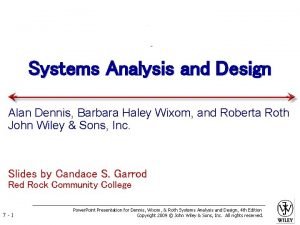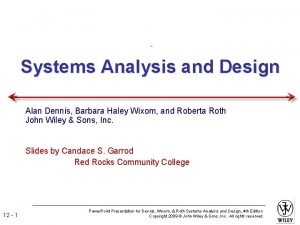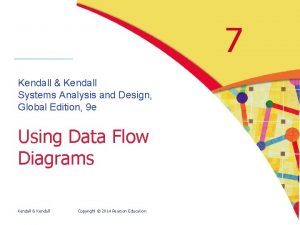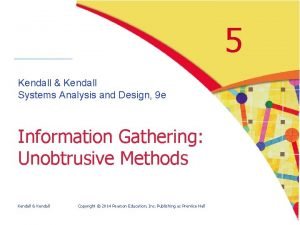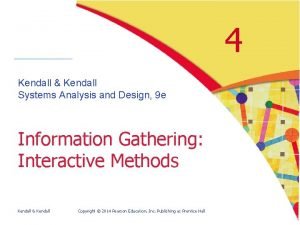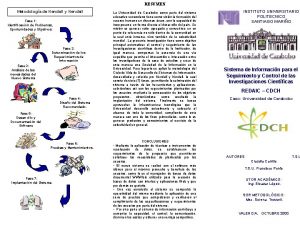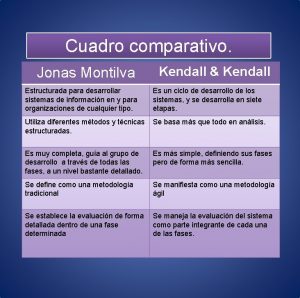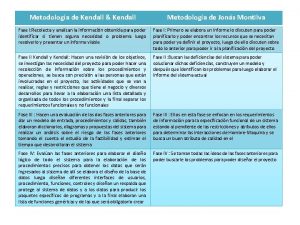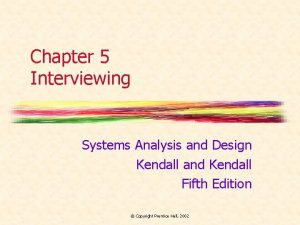2 Kendall Kendall Systems Analysis and Design 9






























- Slides: 30

2 Kendall & Kendall Systems Analysis and Design, 9 e Understanding and Modeling Organizational Systems Kendall & Kendall Copyright © 2014 Pearson Education, Inc. Publishing as Prentice Hall

Learning Objectives • Understand that organizations and their members are systems and that analysts need to take a systems perspective. • Depict systems graphically using context-level data flow diagrams, and entity-relationship models, use cases, and use case scenarios. • Recognize that different levels of management require different systems. • Comprehend that organizational culture impacts the design of information systems. Kendall & Kendall Copyright © 2014 Pearson Education, Inc. Publishing as Prentice Hall 2 -2

Three Main Forces Interacting to Shape Organizations • Levels of management • Design of organizations • Organizational cultures Kendall & Kendall Copyright © 2014 Pearson Education, Inc. Publishing as Prentice Hall 2 -3

Major Topics • Organizations as systems • Depicting systems graphically • Data flow diagram • Entity-relationship model • Use case modeling • Levels of management • Organizational culture Kendall & Kendall Copyright © 2014 Pearson Education, Inc. Publishing as Prentice Hall 2 -4

Organizations as Systems • Conceptualized as systems designed to accomplish predetermined goals and objectives • Composed of smaller, interrelated systems serving specialized functions • Specialized functions are reintegrated to form an effective organizational whole Kendall & Kendall Copyright © 2014 Pearson Education, Inc. Publishing as Prentice Hall 2 -5

System Outputs Serve as Feedback that Compares Performance with Goals (Figure 2. 1) Kendall & Kendall Copyright © 2014 Pearson Education, Inc. Publishing as Prentice Hall 2 -6

Organizational Environments • Community • Physical location • Demographic profile (education, income) • Economic • Market factors • Competition • Political • State and local government • Legal • Federal, state, regional, local laws, and guidelines Kendall & Kendall Copyright © 2014 Pearson Education, Inc. Publishing as Prentice Hall 2 -7

Taking a Systems Perspective • Allows system analyst to understand businesses before they begin their tasks • It is important that members of subsystems realize that they are interrelated with other subsystems • Problems occur when each manager thinks that his/her department is the most important • Bigger problems may occur when that manager rises through the ranks Kendall & Kendall Copyright © 2014 Pearson Education, Inc. Publishing as Prentice Hall 2 -8

Taking a Systems Perspective (Figure 2. 2) Outputs from one department serve as inputs for another such that subsystems are interrelated. Kendall & Kendall Copyright © 2014 Pearson Education, Inc. Publishing as Prentice Hall 2 -9

Perspective of Functional Managers (Figure 2. 3) Kendall & Kendall Copyright © 2014 Pearson Education, Inc. Publishing as Prentice Hall 2 -10

Depicting Systems Graphically • Context-level data flow diagrams • Entity-relationship model • Use case modeling Kendall & Kendall Copyright © 2014 Pearson Education, Inc. Publishing as Prentice Hall 2 -11

Context-Level Data Flow Diagrams • Focus is on the data flowing into and out of the system and the processing of the data • Shows the scope of the system: • What is to be included in the system • The external entities are outside the scope of the system Kendall & Kendall Copyright © 2014 Pearson Education, Inc. Publishing as Prentice Hall 2 -12

The Basic Symbols of a Data Flow Diagram (Figure 2. 4) Kendall & Kendall Copyright © 2014 Pearson Education, Inc. Publishing as Prentice Hall 2 -13

Airline Reservation System (Figure 2. 5) A context-level data flow diagram for an airline reservation system Kendall & Kendall Copyright © 2014 Pearson Education, Inc. Publishing as Prentice Hall 2 -14

Entity-Relationship Model • Focus is on the entities and their relationships within the organizational system • Another way to show the scope of a system Kendall & Kendall Copyright © 2014 Pearson Education, Inc. Publishing as Prentice Hall 2 -15

Relationships • Relationships show the entities are connected • Three types of relationships: • One-to-one • One-to-many • Many-to-many Kendall & Kendall Copyright © 2014 Pearson Education, Inc. Publishing as Prentice Hall 2 -16

Entity-Relationship Example (Figure 2. 7) An entityrelationship diagram showing a manyto-one relationship Kendall & Kendall Copyright © 2014 Pearson Education, Inc. Publishing as Prentice Hall 2 -17

Examples of Different Types of Relationships in E-R Diagrams (Figure 2. 8) Kendall & Kendall Copyright © 2014 Pearson Education, Inc. Publishing as Prentice Hall 2 -18

Entities • Fundamental entity • Associative entity • Attributive entity Kendall & Kendall Copyright © 2014 Pearson Education, Inc. Publishing as Prentice Hall 2 -19

Three Different Types of Entities Used in E-R Diagrams (Figure 2. 9) Kendall & Kendall Copyright © 2014 Pearson Education, Inc. Publishing as Prentice Hall 2 -20

Attributes • Data attributes may be added to the diagram. Kendall & Kendall Copyright © 2014 Pearson Education, Inc. Publishing as Prentice Hall 2 -21

Creating Entity-Relationship Diagrams • List the entities in the organization • Choose key entities to narrow the scope of the problem • Identify what the primary entity should be • Confirm the results of the above through data gathering Kendall & Kendall Copyright © 2014 Pearson Education, Inc. Publishing as Prentice Hall 2 -22

A More Complete E-R Diagram Showing Data Attributes of the Entities (Figure 2. 12 ) Kendall & Kendall Copyright © 2014 Pearson Education, Inc. Publishing as Prentice Hall 2 -23

Use Case Modeling • Describes what a system does without describing how the system does • A logical model of the system • Use case is a view of the system requirements • Analyst works with business experts to develop requirements Kendall & Kendall Copyright © 2014 Pearson Education, Inc. Publishing as Prentice Hall 2 -24

Use Case Diagram • Actor • Refers to a particular role of a user of the system • Similar to external entities; they exist outside of the system • Use case symbols • An oval indicating the task of the use case • Connecting lines • Arrows and lines used to diagram behavioral relationships Kendall & Kendall Copyright © 2014 Pearson Education, Inc. Publishing as Prentice Hall 2 -25

Actor • Divided into two groups • Primary actors: • Supply data or receive information from the system • Provide details on what the use case should do • Supporting actors: • Help to keep the system running or provide help • The people who run the help desk, the analysts, programmers, and so on Kendall & Kendall Copyright © 2014 Pearson Education, Inc. Publishing as Prentice Hall 2 -26

Some components of use case diagrams showing actors, use cases, and relationships for a student enrollment example (Figure 2. 14) Kendall & Kendall Copyright © 2014 Pearson Education, Inc. Publishing as Prentice Hall 2 -27

Why Use Case Diagrams Are Helpful • Identify all the actors in the problem domain • Actions that need to be completed are also clearly shown on the use case diagram • The use case scenario is also worthwhile • Simplicity and lack of technical detail Kendall & Kendall Copyright © 2014 Pearson Education, Inc. Publishing as Prentice Hall 2 -28

The Main Reasons for Writing Use Cases Are Their Effectiveness in Communicating with Users and Their Capturing of User Stories (Figure 2. 18) Kendall & Kendall Copyright © 2014 Pearson Education, Inc. Publishing as Prentice Hall 2 -29

Copyright © 2014 Pearson Education, Inc. Publishing as Prentice Hall Kendall & Kendall Copyright © 2014 Pearson Education, Inc. Publishing as Prentice Hall 2 -30
 Kendall system analysis and design
Kendall system analysis and design Kendall & kendall systems analysis and design
Kendall & kendall systems analysis and design System analysis and design kendall
System analysis and design kendall Kendall and kendall system analysis and design
Kendall and kendall system analysis and design Kendall and kendall system analysis and design
Kendall and kendall system analysis and design System analysis and design kendall
System analysis and design kendall Systems analysis & design in an age of options
Systems analysis & design in an age of options System analysis
System analysis Systems analysis and design in a changing world
Systems analysis and design in a changing world Systems analysis and design in a changing world
Systems analysis and design in a changing world Systems analysis and design alan dennis
Systems analysis and design alan dennis Sad system analysis and design
Sad system analysis and design What is ssadm
What is ssadm Systems analysis and design 5th edition
Systems analysis and design 5th edition Modern systems analysis and design
Modern systems analysis and design Systems analysis and design alan dennis
Systems analysis and design alan dennis Systems analysis and design alan dennis
Systems analysis and design alan dennis Systems analysis and design alan dennis
Systems analysis and design alan dennis Systems analysis and design alan dennis
Systems analysis and design alan dennis Systems analysis and design alan dennis
Systems analysis and design alan dennis Systems analysis and design alan dennis
Systems analysis and design alan dennis Systems analysis and design alan dennis
Systems analysis and design alan dennis Ssadm data flow diagram
Ssadm data flow diagram Radar range equation snr
Radar range equation snr Object-oriented systems analysis and design using uml
Object-oriented systems analysis and design using uml A modern approach to systems analysis and design
A modern approach to systems analysis and design Systems analysis and design in a changing world
Systems analysis and design in a changing world Systems analysis and design in a changing world
Systems analysis and design in a changing world Systems analysis and design in a changing world
Systems analysis and design in a changing world Systems analysis and design alan dennis
Systems analysis and design alan dennis Systems analysis and design alan dennis
Systems analysis and design alan dennis





























